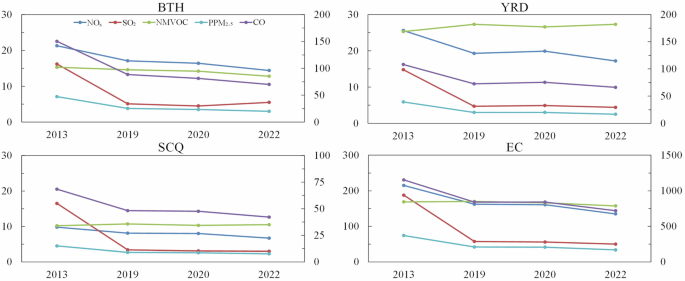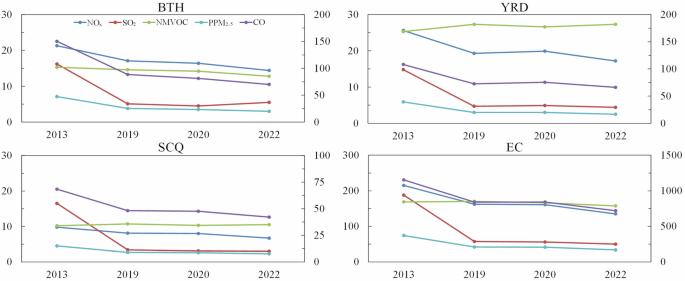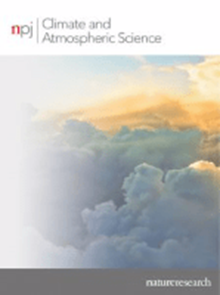Aerosol effects during heat waves in summer 2022 and responses to emission change over China
IF 8.5
1区 地球科学
Q1 METEOROLOGY & ATMOSPHERIC SCIENCES
引用次数: 0
Abstract
This study explores aerosol direct, indirect, and feedback effects on meteorology and fine particulate matter during heat waves of August 2022 over eastern China by using an online coupled regional climate–chemistry–aerosol model. In this period, aerosols exerted mean direct (DRE) and indirect (IRE) radiative effects of −3.9 Wm−2 and −2.4 Wm−2 at TOA, which totally caused a decrease in average surface air temperature by 0.3 °C over east China, accompanied by decreases in PBLH (planetary boundary layer height) and precipitation and an increase in PM2.5 concentration. With the anthropogenic emission reduction from 2013 to 2022, DRE apparently decreased while IRE changed little, leading to a decrease in total aerosol radiative effect (TRE) by 27% at TOA. The weakened TRE resulted in increases in surface air temperature and precipitation by 0.14 °C and 2.7 mm, respectively, on average over east China, with the maximum warming exceeding 0.5 °C in BTH (Beijing–Tianjin–Hebei province). This study highlights a warming trend due to weakened TRE, which may exacerbate heat wave, and an increasing importance of aerosol IRE relative to DRE due to weak sensitivity of cloud properties to aerosol change during the emission reduction.


2022 年夏季热浪期间的气溶胶效应以及对中国上空排放变化的响应
本研究利用区域气候-化学-气溶胶在线耦合模式,探讨了2022年8月中国东部热浪期间气溶胶对气象和细颗粒物的直接、间接和反馈效应。在此期间,气溶胶在TOA上的平均直接(DRE)和间接(IRE)辐射效应分别为-3.9 Wm-2和-2.4 Wm-2,共导致华东地区地表平均气温下降0.3 °C,同时伴有PBLH(行星边界层高度)和降水的减少以及PM2.5浓度的增加。随着2013年至2022年的人为减排,DRE明显下降,而IRE变化不大,导致TOA处气溶胶总辐射效应(TRE)下降了27%。气溶胶总辐射效应的减弱导致华东地区地表气温和降水量平均分别升高了 0.14 ℃ 和 2.7 毫米,其中京津冀地区的升温幅度最大,超过了 0.5 ℃。这项研究强调了由于 TRE 减弱而导致的变暖趋势,这可能会加剧热浪,同时由于减排期间云特性对气溶胶变化的敏感性较弱,气溶胶 IRE 相对于 DRE 的重要性日益增加。
本文章由计算机程序翻译,如有差异,请以英文原文为准。
求助全文
约1分钟内获得全文
求助全文
来源期刊

npj Climate and Atmospheric Science
Earth and Planetary Sciences-Atmospheric Science
CiteScore
8.80
自引率
3.30%
发文量
87
审稿时长
21 weeks
期刊介绍:
npj Climate and Atmospheric Science is an open-access journal encompassing the relevant physical, chemical, and biological aspects of atmospheric and climate science. The journal places particular emphasis on regional studies that unveil new insights into specific localities, including examinations of local atmospheric composition, such as aerosols.
The range of topics covered by the journal includes climate dynamics, climate variability, weather and climate prediction, climate change, ocean dynamics, weather extremes, air pollution, atmospheric chemistry (including aerosols), the hydrological cycle, and atmosphere–ocean and atmosphere–land interactions. The journal welcomes studies employing a diverse array of methods, including numerical and statistical modeling, the development and application of in situ observational techniques, remote sensing, and the development or evaluation of new reanalyses.
 求助内容:
求助内容: 应助结果提醒方式:
应助结果提醒方式:


